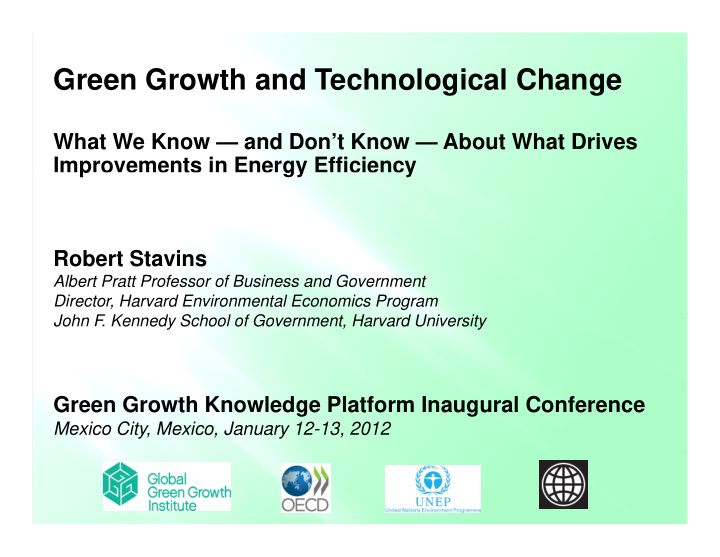



Green Growth and Technological Change What We Know — and Don’t Know — About What Drives Improvements in Energy Efficiency p gy y Robert Stavins Albert Pratt Professor of Business and Government Director, Harvard Environmental Economics Program John F. Kennedy School of Government, Harvard University Green Growth Knowledge Platform Inaugural Conference Mexico City, Mexico, January 12-13, 2012
Green Growth • First what’s “green growth?” • First, what s green growth? • United Nations: “Green Growth is the process of greening a conventional economic system and a strategy to arrive at a green economy, ” … and … “Green Economy can be defined as an economy where economic prosperity can go hand-in-hand with ecological sustainability .” • “Green growth” may be a new phrase for “sustainable development” • We then need to ask whether green growth is: • Nothing more nor less than addressing ordinary “market failures,” including environmental externalities? … or … • An activist call to coordinate growth & environmental policies? • An activist call to coordinate growth & environmental policies? ... or … or • A conviction that green policy is not only good for broadly-defined welfare, but for narrowly-defined GDP growth? • Whatever it means, green growth is tightly linked with technological change 2
For green growth, technological change with regard to energy efficiency is very important g y p gy y • Why? Because global energy consumption is on a path to grow 50% over the next 25 years g y • increased air pollution, greenhouse gas emissions, oil consumption, and energy prices • And energy efficiency improvements are an important mechanism for decreasing energy consumption • Important questions: • How do people & businesses make energy efficiency decisions? • What are the effectiveness, costs, and benefits of energy- efficiency policies? • In the context of green-growth, a central issue is the “energy paradox” or “energy efficiency gap” …. 3
What is the “energy paradox” or “energy- efficiency gap?” efficiency gap? • It is the apparent reality that energy-efficiency technologies that would pay off for adopters … are nevertheless not adopted. p y p p • Let’s be clear about what adoption means” • Three stages of technological change • Three stages of technological change • Invention – creation of new equipment (in the laboratory) • Innovation – commercialization, i.e. taking it from the laboratory to the showroom floor • Diffusion – gradual process of adoption (purchase) of product • Diffusion – gradual process of adoption (purchase) of product • [And, of course, utilization – use of the adopted product] • Energy paradox is mainly about diffusion E d i i l b t diff i • So, what can explain the existence of the paradox/gap? 4
Potential Explanations of the Paradox/Gap • Market Failure Explanations • Market-Failure Explanations • Information Problems • Principal-agent issues (e.g., renters/landlords) • L Lack of information, asymmetric information k f i f ti t i i f ti • Energy Market Failures • Externalities – environmental, security • Average cost electricity pricing Average-cost electricity pricing • Capital Market Failures (liquidity constraints) • Innovation Market Failures (R&D spillovers) • Behavioral Explanations B h i l E l ti • Inattentiveness/salience issues • Bounded rationality, heuristic decision-making • Model and Measurement Explanations • Unobserved costs of adoption • Product characteristics/attributes • Heterogeneity in demand across potential adopters • Uncertainty (real, not informational – e.g., future energy prices) 5
Some Policy Implications • What about subsidies as a diffusion (adoption) policy? ( p ) p y • Can provide perverse incentive to increase energy use (rebound effect) • Require large public expenditures per unit of effect (infra-marginal units) • What about conventional , command-and-control regulations? • Major effect is to remove some technologies from the market (examples: CAFE standards, energy efficiency standards) CAFE standards energy-efficiency standards) • Bottom Line : There are two distinct market failures – environmental externality and public-good nature of information generated by R&D • Pricing of externality is necessary, but not sufficient • Direct technology policy is necessary, but not sufficient • Concl sion from pre io s research Conclusion from previous research: • Theory & empirical evidence: innovation & diffusion do respond to market incentives • But double market failure clarifies the case for broader-based public support for technology innovation (and perhaps diffusion) 6
More Research is Needed More Research is Needed • Research Problem • Bricks • Walls • House • What does existing evidence tell us when assembled? • Where are there inconsistencies? • What are the most important knowledge gaps? • A very substantial agenda for research, communication, and action 7
For More Information Harvard Environmental Economics Program www hks harvard edu/m-rcbg/heep/ www.hks.harvard.edu/m-rcbg/heep/ Blog: An Economic View of the Environment Bl A E i Vi f h E i http://www.robertstavinsblog.org/ www.stavins.com 8
Appendix: Alternative notions of the “energy-efficiency gap” of the energy efficiency gap Increasing energy efficiency Technologists’ Optimum Theoretical Social Optimum Eliminate “market Set aside corrective policies barriers” to energy that cannot be implemented Eliminate efficiency, such as at acceptable cost environmental high discount rates externalities and and inertia, ignore market failures in heterogeneity heterogeneity energy supply True Social Optimum Economists’ Narrow Optimum Narrow Optimum Net effect of corrective policies that can pass a Eliminate market failures in benefit/cost test the market for energy- efficient technologies Increasing economic efficiency Baseline 9
Recommend
More recommend